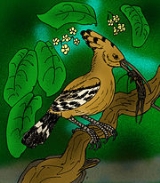
Giant Hoopoe
Encyclopedia
The Giant Hoopoe also known as Saint Helena Giant Hoopoe or Saint Helena Hoopoe, is an extinct species of Hoopoe
(family
Upupidae), known exclusively from an incomplete subfossil
skeleton.
It was endemic to the island of Saint Helena
in the South Atlantic
. It was much larger than its European and African relatives, and was completely flightless. The first analysis of this species was given in 1963 by the British zoologist Philip Ashmole, who discovered in the Dry Gut sediments in the east of Saint Helena a left Humerus
which differed significantly from that of other Upupidae.
The incomplete skeleton
which was found in 1975 by palaeontologist
Storrs L. Olson
consists of both coracoids and the left femur
. It is presumed to have become extinct soon after Saint Helena was discovered and colonized in 1502, due to a combination of the introduction of predators such as black rat
s, and domestic cat
s, and habitat destruction.
As all known hoopoes are insectivores that feed primarily on large insects, the Giant Hoopoe may have been a predator of the Saint Helena Giant Earwig (Labidura herculeana), an insect which has not been seen alive since 1967.
Hoopoe
The Hoopoe is a colourful bird that is found across Afro-Eurasia, notable for its distinctive 'crown' of feathers. It is the only extant species in the family Upupidae. One insular species, the Giant Hoopoe of Saint Helena, is extinct, and the Madagascar subspecies of the Hoopoe is sometimes...
(family
Family (biology)
In biological classification, family is* a taxonomic rank. Other well-known ranks are life, domain, kingdom, phylum, class, order, genus, and species, with family fitting between order and genus. As for the other well-known ranks, there is the option of an immediately lower rank, indicated by the...
Upupidae), known exclusively from an incomplete subfossil
Subfossil
Subfossil refers to remains whose fossilization process is not complete, either for lack of time or because the conditions in which they were buried were not optimal for fossilization....
skeleton.
It was endemic to the island of Saint Helena
Saint Helena
Saint Helena , named after St Helena of Constantinople, is an island of volcanic origin in the South Atlantic Ocean. It is part of the British overseas territory of Saint Helena, Ascension and Tristan da Cunha which also includes Ascension Island and the islands of Tristan da Cunha...
in the South Atlantic
Atlantic Ocean
The Atlantic Ocean is the second-largest of the world's oceanic divisions. With a total area of about , it covers approximately 20% of the Earth's surface and about 26% of its water surface area...
. It was much larger than its European and African relatives, and was completely flightless. The first analysis of this species was given in 1963 by the British zoologist Philip Ashmole, who discovered in the Dry Gut sediments in the east of Saint Helena a left Humerus
Humerus
The humerus is a long bone in the arm or forelimb that runs from the shoulder to the elbow....
which differed significantly from that of other Upupidae.
The incomplete skeleton
Skeleton
The skeleton is the body part that forms the supporting structure of an organism. There are two different skeletal types: the exoskeleton, which is the stable outer shell of an organism, and the endoskeleton, which forms the support structure inside the body.In a figurative sense, skeleton can...
which was found in 1975 by palaeontologist
Paleontology
Paleontology "old, ancient", ὄν, ὀντ- "being, creature", and λόγος "speech, thought") is the study of prehistoric life. It includes the study of fossils to determine organisms' evolution and interactions with each other and their environments...
Storrs L. Olson
Storrs L. Olson
Storrs Lovejoy Olson is an American biologist and ornithologist from the Smithsonian Institution. He is one of the world's foremost avian paleontologists....
consists of both coracoids and the left femur
Femur
The femur , or thigh bone, is the most proximal bone of the leg in tetrapod vertebrates capable of walking or jumping, such as most land mammals, birds, many reptiles such as lizards, and amphibians such as frogs. In vertebrates with four legs such as dogs and horses, the femur is found only in...
. It is presumed to have become extinct soon after Saint Helena was discovered and colonized in 1502, due to a combination of the introduction of predators such as black rat
Black Rat
The black rat is a common long-tailed rodent of the genus Rattus in the subfamily Murinae . The species originated in tropical Asia and spread through the Near East in Roman times before reaching Europe by the 1st century and spreading with Europeans across the world.-Taxonomy:The black rat was...
s, and domestic cat
Cat
The cat , also known as the domestic cat or housecat to distinguish it from other felids and felines, is a small, usually furry, domesticated, carnivorous mammal that is valued by humans for its companionship and for its ability to hunt vermin and household pests...
s, and habitat destruction.
As all known hoopoes are insectivores that feed primarily on large insects, the Giant Hoopoe may have been a predator of the Saint Helena Giant Earwig (Labidura herculeana), an insect which has not been seen alive since 1967.

